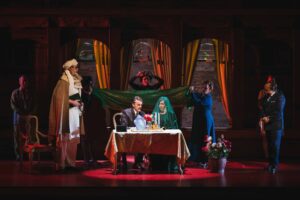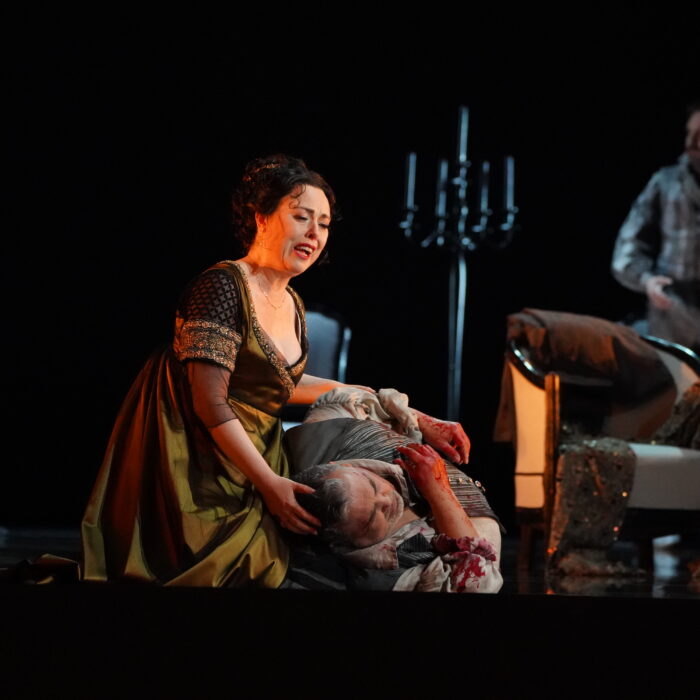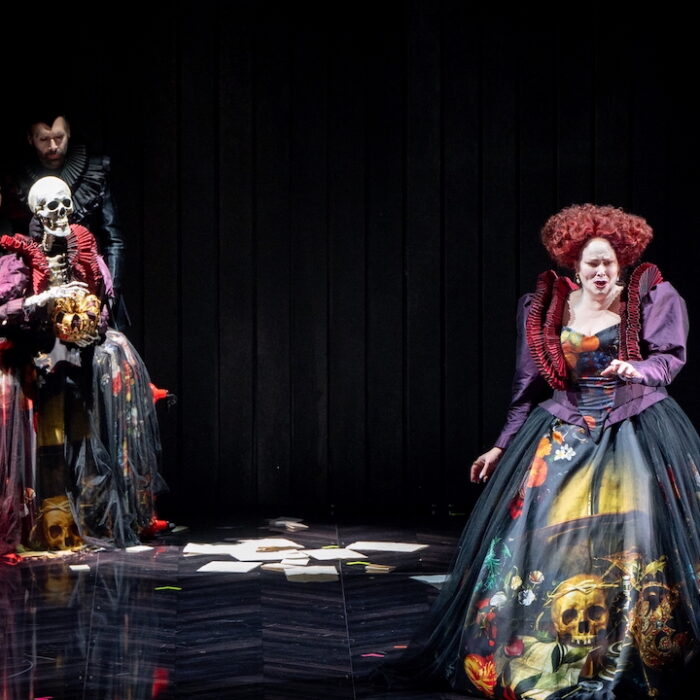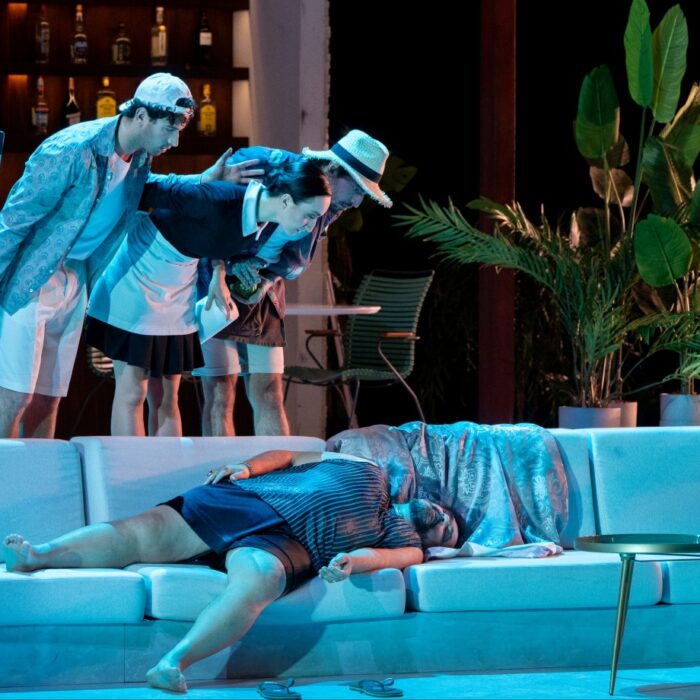
Seattle Opera 2022-23 Review: A Thousand Splendid Suns
Stephen Kitsakos’ New Opera Falls Flat on Multiple Fronts
By Gavin BorchertPhoto: Antone Patterson
An opera company’s highest calling is to commission new work—to contribute to the history of opera, to leave a legacy. Seattle Opera has done so, memorably, with “A Thousand Splendid Suns.” The piece, which opened February 25 in Seattle’s McCaw Hall and ends March 11, is Seattle Opera’s first mainstage world premiere since Daron Hagen’s “Amelia” from 2010. Sheila Silver—a Seattle-born UW alumna—wrote the music, and Stephen Kitsakos based his libretto on Khaled Hosseini’s 2007 novel, a multigenerational saga (the story stretches from 1974 to 2001) of the plight of three generations of women in war-torn, Taliban-ruled Afghanistan.
The Story
Mariam (Karin Mushegain), from a more traditional background, is given in marriage at 15 to the oppressively traditional Rasheed (John Moore). Twenty years later, Laila (Maureen McKay), whose upbringing was more modern, is rescued by Rasheed after a Soviet bomb destroys her house and kills her parents. Tired of Mariam, he takes Laila as a second wife, who clashes with, then finds an ally in the embittered older woman.
Silver’s music is colorful and (though it lies easily on the ear) absorbing. While preparing for her work on the opera, she traveled to study Hindustani music, which perfumed her score both orchestrally, through the prominent use of bamboo flute and tabla drums, and harmonically, drawing on ragas, traditional scale patterns.
Her music decorates the story, often very beautifully, but less often carries or propels it. Scenes where it includes the opening argument between Mariam and her mother (Tess Altiveros), the final Mariam/Rasheed confrontation, and the beguiling sonic twinkling of the closing scene. The luscious Act two farewell of Laila and her boyfriend Tariq (Rafael Moras) is another example, based on rolling waves of upward-sweeping arpeggios (an effect, though, that Silver had used a number of times already in the piece). The lovers disappear offstage for a minute or two, but an opulent orchestral interlude spells out pretty clearly what they’re up to.
Vocally, the cast is solid throughout, the most impressive being Moras, a tenor making his Seattle Opera debut. He earned the loudest curtain-call ovation. Seattle Opera general director Christina Scheppelmann may have already received many requests to bring him back.
Artistic Choices Reflect Problematic Operatic Tropes
On the podium was Viswa Subbaraman, and the brief stage/pit imbalance of the opening scenes ironed itself out quickly.
Set designer Misha Kachman relies a lot—a lot—on a turntable for scene changes. During one stretch of Act one, toggling between Mariam’s and Laila’s stories, it seems to turn every two minutes; becoming a lumbering distraction. The acting, in stage director Roya Sadat’s conception, is naturalistic, though Silver’s text setting, asking the singers to repeat lines constantly, is not; it slows the action. (“Suns” comes in at Two acts of 80 minutes each.)
Sadat may have been responsible for the thread of cutesiness, which I did not expect for a story so grim in outline, that runs through the piece and works against its gravity, especially in the conventional stage girlishness of the scenes of Mariam and Laila as teens (lots of skirt-twirling and—ugh—skipping) and in the Laila/Tariq love scene that closes Act one.
This vocally climactic farewell, as a theatrical device, is 100% Verdi. In fact, as far as the strategies, ploys, and tricks of operatic storytelling are concerned, there is nothing here you can’t find in the mainstream of Italian opera—not only the love duet (complete with balcony), a bustling market scene, a villain who does everything but twirl his mustache, a juicy murder, and a transfiguring death finale for the heroine. All this gave the impression that Kitsakos’ priority in adapting the novel, rather than crafting a tight narrative, was locating and extracting operatic hooks.
Among all the tropes “Suns” unabashedly repurposes, many have recently drawn criticism in standard-repertory works, which left me with a lot of questions—especially considering that Seattle Opera’s promotional materials took pains to point up the opera’s contemporary relevance and feminist bona fides:
- Why is depicting the abuse of women to push melodramatically the audience’s buttons considered problematic in “Tosca” or “Madame Butterfly,” but not here?
- Why are the Orientalisms of “Lakmé” or “Aida” or, again, “Butterfly” considered cultural appropriation, but not here?
- And why is a woman’s death, rationalized and glorified as a redemptive noble sacrifice, considered misogynist in “Tannhäuser” or “The Flying Dutchman,” but not here?
The straightforward naturalism of the production’s costumes, sets, and acting and the vivid local color on stage and in the orchestra, all presumably intended to heighten the story’s emotional impact, instead distanced it from us viewers. The meticulous way Seattle Opera’s staging confines the action to a very particular time and place implies that the horrific brew of pathological misogyny, religious fundamentalism and totalitarianism that wrings such tragedy on the opera’s characters is a problem only in Afghanistan.
Contemporary Relevance?
If you’ve turned on a television at any point in the past seven years, you cannot have failed to notice that these are—increasingly day-by-day—problems in America too. But instead of being offered as a cautionary tale, this production of “Suns” gives three hours of othering. The opera coddles us into believing this is how they behave, those non-Christians, way over there on the other side of the planet.
Every way in which “Suns” could have been staged to allude, as an allegorical subtext, to the rise of fascism here and now was a path not taken. There is no subtext; everything in the opera means exactly what it appears to, and no more. And so the combination of WYSIWYG (What you see is what you get) realism and the free use of the coziest operatic conventions mean that all these social issues are safely cordoned off in opera-world so that no one watching “Suns” need feel indicted. And if this comforts anyone in the audience into thinking, “Surely that can’t happen here,” then “Suns” is not only irresponsible, it’s actively harmful.
And in this context, it was distressing to see an almost entirely white Seattle audience goaded into cheering (yes, literally cheering) the revenge murder of a brown person. Rasheed’s death may be justifiable, but the crimes being avenged are crimes happening here, too, and everywhere, and staging this story to allow (even encourage) the audience to feel morally superior was hypocritical. If “Suns” is to function as anything more than a mere travelogue of trauma, it needs to be approached and presented in such a way that the universality of its human emotions, motivations, and responses is apparent—just below, if not on, the surface.
“But it’s not about us, it’s their story, a stirring tale of the strength, resilience, and resistance of Afghan women,” you might object. However, it lets us “enlightened” (white) people off the hook for doing the same things the opera’s villain did, in a social system growing increasingly similar.
Telling diverse stories is a good and necessary thing in any performing art. Telling stories in a way that allows the audience to feel superior to the story being told defeats the purpose. “Suns” is a worthy piece, but the approach to it needs to be rethought for the subsequent productions it definitely deserves.


